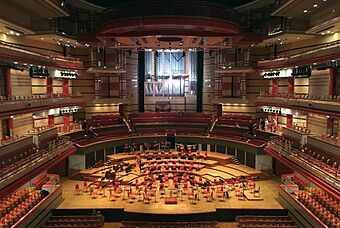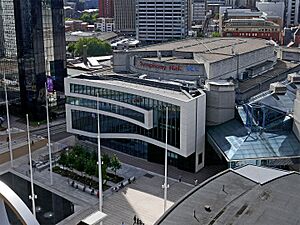Symphony Hall, Birmingham facts for kids

Symphony Hall platform, organ and movable acoustic canopy
|
|
| Location | Broad Street, Birmingham, United Kingdom |
|---|---|
| Coordinates | 52°28′43″N 1°54′38″W / 52.47861°N 1.91056°W |
| Owner | Performances Birmingham Limited |
| Type | Concert hall |
| Capacity | 2,262 |
| Construction | |
| Opened | 1991 |
| Construction cost | £30 million |
| Architect | Percy Thomas Partnership Renton Howard Wood Levin |
Symphony Hall is a large concert venue in Birmingham, England. It has 2,262 seats, making it a big space for music and performances. Queen Elizabeth II officially opened it on June 12, 1991.
This amazing hall is the home of the City of Birmingham Symphony Orchestra. It hosts about 270 events every year! These events include jazz, classical music, rock, pop, and even comedy shows. It's also used for important meetings and business events.
The inside of Symphony Hall was designed to look like famous concert halls in Europe, such as the Musikverein in Vienna and the Concertgebouw in Amsterdam. In 2016, an expert named Leo Beranek said that Symphony Hall has the best sound quality (acoustics) in the United Kingdom. He even ranked it as the seventh best in the world! To show how good the sound is, before it opened, a test proved that if you dropped a pin on the stage, you could hear it from anywhere in the hall.
How Symphony Hall Was Built
Symphony Hall was designed by special architects and sound experts. They wanted to make sure the hall sounded perfect for every type of music.
One cool thing about the hall is its "acoustic flexibility." This means the sound can be changed to fit the performance.
- Behind the stage and along the sides, there's a hidden space called a reverberation chamber. This space can be opened or closed to make the hall sound bigger or smaller.
- There's also a special canopy (a kind of roof) above the stage that can be moved up or down.
- Walls have panels that can slide out or in. These "dampening panels" help control how sound bounces around.
- Even the walls and ceiling are super thick, about 200 millimetres (8 in) of concrete, to keep sounds inside and unwanted noises out.
The hall is built very close to a railway line. To stop train vibrations from disturbing concerts, the hall sits on special rubber cushions. The railway track itself also has these cushions! Thick concrete walls protect the hall from noisy traffic on Broad Street.
In 2001, a huge organ with 6,000 pipes was added to the hall. It was built in Germany and is now the largest organ in the UK that uses a mechanical action.
Community and Education
Symphony Hall, along with Town Hall, is run by a company called B:Music Limited. This company is a charity, which means it does good work for the community. They have a special department that works with schools, community groups, and families. Each year, they help about 12,000 young people and 6,000 adults learn about music and arts through different projects.
Images for kids
See also
 In Spanish: Symphony Hall (Birmingham) para niños
In Spanish: Symphony Hall (Birmingham) para niños


